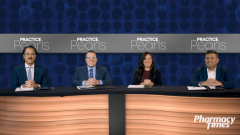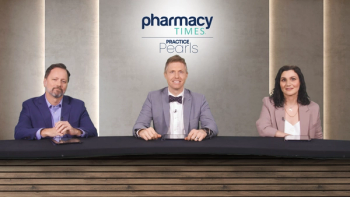
Shared Decision-Making in Hemophilia A Therapies
Robert Sidonio Jr, MD, MSc, discusses patient-centered therapy choices, highlighting the diverse options and considerations for hemophilia A treatment.
Episodes in this series

Jonathan Ogurchak, PharmD, CSP: Dr Sidonio, there’s oftentimes some shared decision-making that comes into play here. When you’re trying to select therapies, you’re looking at patient outcomes, making sure that it’s the best for the patient. What are some of the things that you would look at for your patients when you’re trying to decide between therapies that might be utilized for a hemophilia A patient?
Robert Sidonio Jr, MD, MSc: We were just talking a minute ago about how when I first started out, you only had to know a few factor VIII product names. There were all 4, plasma-derived, recombinant factor VIII products. But in the last 10 years, there’s just been an explosion. It’s a golden age of hemophilia.
There are lots of options for this patient population. One of the things I’ve learned over the years is that this community really values choice. They really feel, and I think we all do as well, that not every factor VIII product works for every single patient. There shouldn’t be 1 product that every patient is on. They like the option of trying, attempting new products.
There may be some nuances or differences. With that in hand now when we talk to a new family, it’s a very long discussion because we bring up all the products that Dr Schrade just mentioned, all the options that you could choose. There isn’t a wrong option. There may be one that’s slightly more popular than the others. There’s generally been a shift from using plasma-derived or recombinant factor VIII products, and even extended half-life products. It’s moved more into the non–factor VIII products like emicizumab.
We really are trying to guide them. There may be many things that they’re thinking of, as mentioned before by Dr Chowdhry, that there is the history of contamination of blood products, even though we know that these products are safe now, that obviously colors their decision-making, so some families may not be as interested in plasma-derived products, even though we know that they are safe now. But obviously you have to respect that history. Sometimes it’s as simple as, “My brother is on this product, and I want this new child to be on the same product”. We at least guide them in what the differences are. We go over some of the differences, the modifications.
Some families feel very strongly about inert ingredients, and some feel strongly about whether it’s a human cell line or not. You just have to sort of offer all those options and remind them that they’re all reasonable options. Even if you don’t like this option, you could consider changing in the future. You just have to lay out all the different options for them, sort of incorporate their values, and just guide them to make the decision that you feel like is reasonable.
Sometimes it takes multiple visits [for] a new patient. We often hope that we’re making these decisions before they’re in the emergency [department] and need to be treated for a bleed. We try to emphasize, we really want to have these discussions before it becomes an emergency, and now we have to give something, or you’re going to have to get whatever’s on the formulary, you don’t get an option. We at least try to have those options, prepare for it. It’s obviously a much longer conversation than it was 15 years ago. But it’s great for the community. They have so many different options. We know that they often will ask other community members as well as they may get their input as well. We just really try to guide them in making the decision that makes the most sense for them.
Jonathan Ogurchak, PharmD, CSP: Dr Schrade was talking a little bit about the kind of the legacy products vs newer entities like emicizumab, like what types of patients would benefit most from a product like emicizumab vs traditional factor VIII.
Robert Sidonio Jr, MD, MSc: This is 1 of the most disruptive products that’s entered the hemophilia community since the recombinant products. It’s really shifted completely.... Over the years, you see that this is the predominant choice for those with severe hemophilia A. Probably much more commonly used in younger patients. Older patients may have done really, really well on their factor products. They feel like if I haven’t had many bleeding events in the last 5 years, I feel very comfortable with doing 4 injections. We don’t feel the need to say, you need to switch this product. There’s that value, of course. When we look at who is the best patient for emicizumab, it’s really shifted to become the gold standard of care in the United States, at least for those with severe disease.
When you think about young children, it’s very difficult to administer intravenous products. It’s very difficult to get that product in the child in the first 2 years of life. It’s just technically and logistically difficult without using a central line. A lot of families are not interested in putting in central lines. That was pretty much standard 10, 15 years ago. That, when you were born, [and] you had severe hemophilia A, we’re talking about putting a portacath in you almost immediately. Now they have this option where they could start emicizumab as early as immediately after they’re born. I know some practices started within the first 2 months of life, and so the idea is that you’re protecting him from this potential of intracranial hemorrhage, which is impossible to predict. You don’t know who’s going to develop that, and so that’s been an option. I think as they get older, other products like factor products become another option. Some families like the idea of, like Dr Schrade said, you’re missing a factor and then I want to replace it with the same factor. They don’t like the idea of a mimetic for whatever reason. Some patients feel that the injection burns and is painful and when you do IVs [intravenous administrations] it’s maybe not as painful, so there’s decisions we let them [made]. Probably when you think about emicizumab in the young children, as they get older, the really active child, some of the newer factor products have very extended half-lives that might be a better option for them if they do this. We have a lot of very active children who are on more frequent standard half-life products or they’re on 1 of the newer extended half-life products. As you get older and you accumulate more comorbidities, there are a lot of my adult colleagues who feel like they like the idea of titrating a factor product. If you’re talking about people who have hypertension, high cholesterol, or history of stroke, you start to worry about normalizing hemostasis in this population. It may not be ideal and so factor products are often considered in that population, but overall emicizumab has sort of entered most scenarios. But it becomes an option; factor products do have a role and I think in nonsevere hemophilia, economically it makes sense too, if you have someone with moderate hemophilia or mild disease but they have a severe phenotype giving factor products, you can titrate the dose that works best for them. Maybe there’s periods of time where they don’t need factor products, maybe they’re not that active, and so I think that product is really useful in that population, and that’s what we use a lot in right now.
Transcript is AI generated and reviewed by a Pharmacy Times editor.
Newsletter
Stay informed on drug updates, treatment guidelines, and pharmacy practice trends—subscribe to Pharmacy Times for weekly clinical insights.











































































































































































































